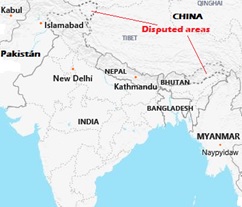Surrounded on all sides by foes, Xi Jinping faces mounting obstacles to his goal of  ‘national rejuvenation.’
‘national rejuvenation.’
May 28.– As China reopens its economy after months of lockdowns, the country’s leadership has initiated a broad offensive to expand its influence at home and abroad. A new Hong Kong security law that attemps to stamp out dissent in the autonomous region sparked another round of anti-Mainland protests. Meanwhile, China has scaled up military exercises in the Yellow Sea, which will extend into the South China Sea this summer.
Now a standoff between forces on the Sino–Indian border has opened a new front in Beijing’s offensive. This latest development in a decades-old dispute between the world’s two most populous countries underscores the myriad obstacles that Chinese president Xi Jinping faces in his goal of “national rejuvenation.”
Over the past month, China’s People’s Liberation Army (PLA) has reportedly moved at least 5,000 troops to the “Line of Actual Control,” which demarcates the border between China and India. The mobilization of troops to the Galwan River valley, on the westernmost border between the two countries, led to a clash on May 5, when Chinese and Indian forces engaged in fisticuffs and stone-throwing. In keeping with Sino–Indian border protocols, both sides were unarmed, but the skirmish — and another in the Naku La region near Tibet on May 12 — left several troops injured.
Though the facts on the ground in the remote Himalayan border region are unclear, satellite imagery of the area confirms a rapid military buildup by Chinese forces since April. India has responded in kind, mobilizing troops and artillery to the area in recent days, according to Bloomberg News. An Indian policy analyst who requested anonymity adds that there is also evidence that the two sides have moved aircraft closer to the region.
(...)
[ Full text ]
Comments powered by CComment